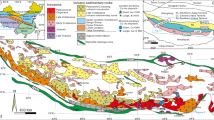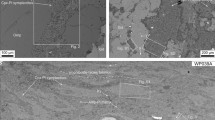Abstract
The system KAlO2–MgO–SiO2–H2O–CO2 has long been used as a model for the processes of granulite-facies metamorphism and the development of orthopyroxene-bearing mineral assemblages through the breakdown of biotite-bearing assemblages. There has been considerable controversy regarding the role of carbon dioxide in metamorphism and partial melting. We performed new experiments in this system (at pressures of 342 to 1500 MPa with T between 710 and 1045 °C and X Fl H2O between 0.05 and 1.00), accurately locating most of the dehydration and melting equilibria in P-T-X Fl H2O space. The most important primary result is that the univariant reaction Phl + Qtz + Fl = En + Sa + melt must be almost coincident with the fluid-absent reaction (Phl + Qtz = En + Sa + melt) in the CO2-free subsystem. In conjunction with the results of previous measurements of CO2 solubility in silicate melts and phase equilibrium experiments, our theoretical analysis and experiments suggest that CO2 cannot act as a flux for partial melting. Crustal melting in the presence of H2O–CO2 mixed fluids will always occur at temperatures higher than with pure H2O fluid present. Magmas produced by such melting will be granitic (s.l.) in composition, with relatively high SiO2 and low MgO contents, irrespective of the H2O–CO2 ratio in any coexisting fluid phase. We find no evidence that lamprophyric magmas could be generated by partial fusion of quartz-saturated crustal rocks. The granitic melts formed will not contain appreciable dissolved CO2. The channelled passage of hot CO2-rich fluids can cause local dehydration of the rocks through which they pass. In rock-dominated (as opposed to fluid-dominated) systems, minor partial melting can also occur in veins initially filled with CO2-rich fluid, as dehydration and local disequilibrium drive the fluid towards H2O-rich compositions. However, CO2 is unlikely to be a significant agent in promoting regional granulite-grade metamorphism, melting, magma generation, metasomatism or long-range silicate mass transfer in Earth's crust. The most viable model for the development of granulite-facies rocks involves the processes of fluid-absent partial melting and withdrawal of the melt phase to higher crustal levels.
Similar content being viewed by others
Author information
Authors and Affiliations
Additional information
Received: 28 November 1996 / Accepted: 25 June 1997
Rights and permissions
About this article
Cite this article
Clemens, J., Droop, G. & Stevens, G. High-grade metamorphism, dehydration and crustal melting: a reinvestigation based on new experiments in the silica-saturated portion of the system KAlO2–MgO–SiO2–H2O–CO2 at P≤ 1.5 GPa. Contrib Mineral Petrol 129, 308–325 (1997). https://doi.org/10.1007/s004100050339
Issue Date:
DOI: https://doi.org/10.1007/s004100050339




